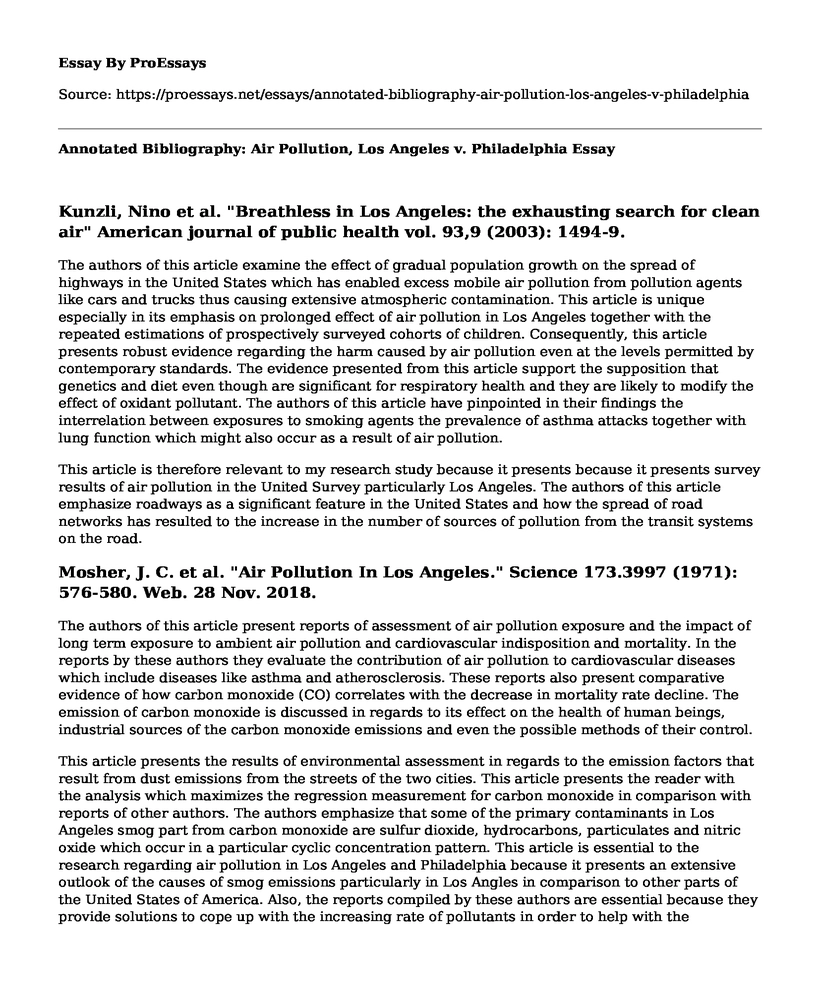Kunzli, Nino et al. "Breathless in Los Angeles: the exhausting search for clean air" American journal of public health vol. 93,9 (2003): 1494-9.
The authors of this article examine the effect of gradual population growth on the spread of highways in the United States which has enabled excess mobile air pollution from pollution agents like cars and trucks thus causing extensive atmospheric contamination. This article is unique especially in its emphasis on prolonged effect of air pollution in Los Angeles together with the repeated estimations of prospectively surveyed cohorts of children. Consequently, this article presents robust evidence regarding the harm caused by air pollution even at the levels permitted by contemporary standards. The evidence presented from this article support the supposition that genetics and diet even though are significant for respiratory health and they are likely to modify the effect of oxidant pollutant. The authors of this article have pinpointed in their findings the interrelation between exposures to smoking agents the prevalence of asthma attacks together with lung function which might also occur as a result of air pollution.
This article is therefore relevant to my research study because it presents because it presents survey results of air pollution in the United Survey particularly Los Angeles. The authors of this article emphasize roadways as a significant feature in the United States and how the spread of road networks has resulted to the increase in the number of sources of pollution from the transit systems on the road.
Mosher, J. C. et al. "Air Pollution In Los Angeles." Science 173.3997 (1971): 576-580. Web. 28 Nov. 2018.
The authors of this article present reports of assessment of air pollution exposure and the impact of long term exposure to ambient air pollution and cardiovascular indisposition and mortality. In the reports by these authors they evaluate the contribution of air pollution to cardiovascular diseases which include diseases like asthma and atherosclerosis. These reports also present comparative evidence of how carbon monoxide (CO) correlates with the decrease in mortality rate decline. The emission of carbon monoxide is discussed in regards to its effect on the health of human beings, industrial sources of the carbon monoxide emissions and even the possible methods of their control.
This article presents the results of environmental assessment in regards to the emission factors that result from dust emissions from the streets of the two cities. This article presents the reader with the analysis which maximizes the regression measurement for carbon monoxide in comparison with reports of other authors. The authors emphasize that some of the primary contaminants in Los Angeles smog part from carbon monoxide are sulfur dioxide, hydrocarbons, particulates and nitric oxide which occur in a particular cyclic concentration pattern. This article is essential to the research regarding air pollution in Los Angeles and Philadelphia because it presents an extensive outlook of the causes of smog emissions particularly in Los Angles in comparison to other parts of the United States of America. Also, the reports compiled by these authors are essential because they provide solutions to cope up with the increasing rate of pollutants in order to help with the increasing rate of mortality as a result of lung diseases due to smog emissions.
Cite this page
Annotated Bibliography: Air Pollution, Los Angeles v. Philadelphia. (2022, Mar 28). Retrieved from https://proessays.net/essays/annotated-bibliography-air-pollution-los-angeles-v-philadelphia
If you are the original author of this essay and no longer wish to have it published on the ProEssays website, please click below to request its removal:
- The Need for Environment Conservation - A Research Paper on Ecology
- The Use of Renewable Sources of Energy in the Construction of Green Buildings Paper Example
- Articles Review on Climate Change Paper Example
- Essay Sample on The Green New Deal
- Research Paper on Subway's Environmental Sustainability Practices
- NEPA Section 101: Federal Agencies Must Protect Environment - Essay Sample
- Essay Sample on Climate Change & Extreme Weather: Causes & Effects







